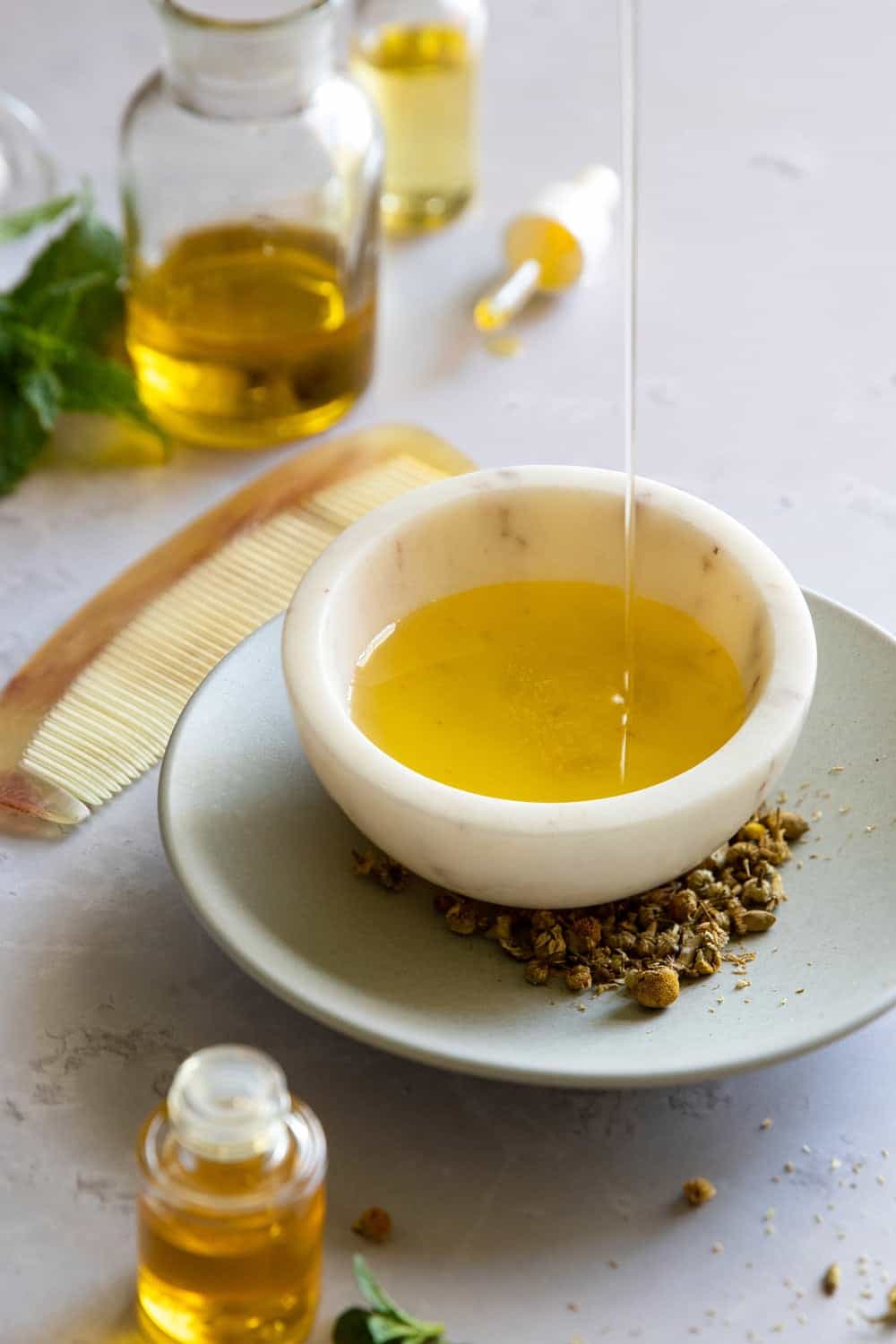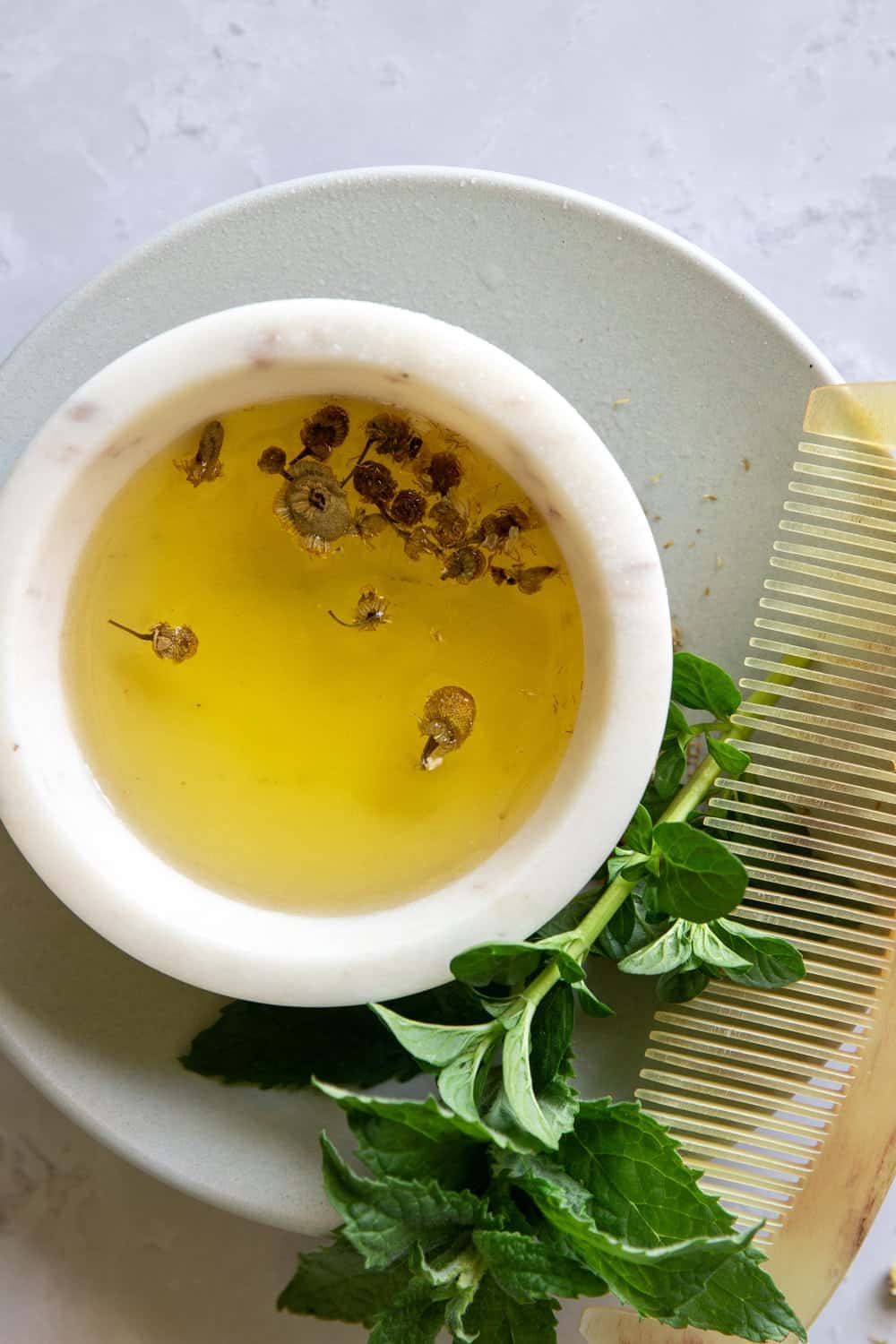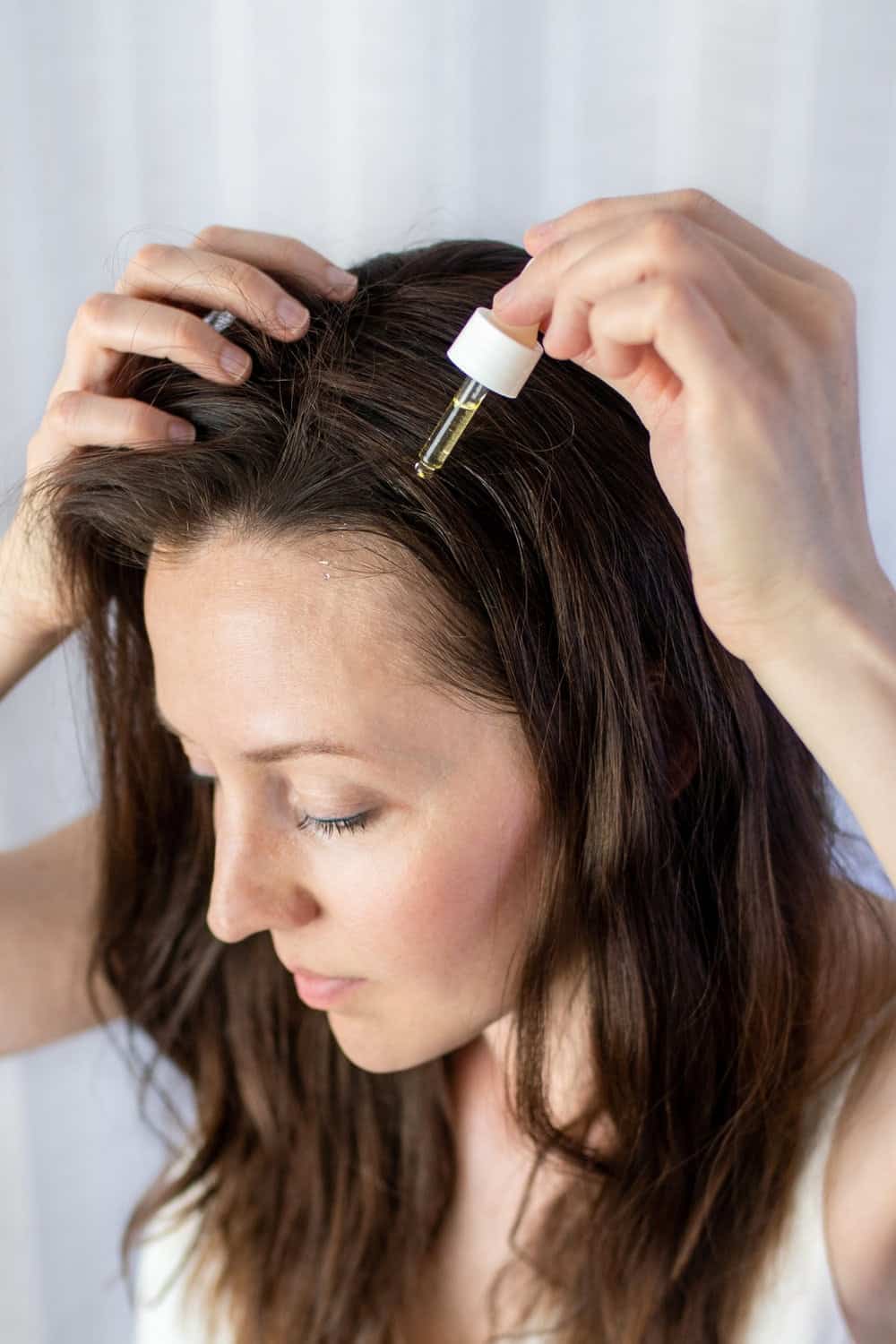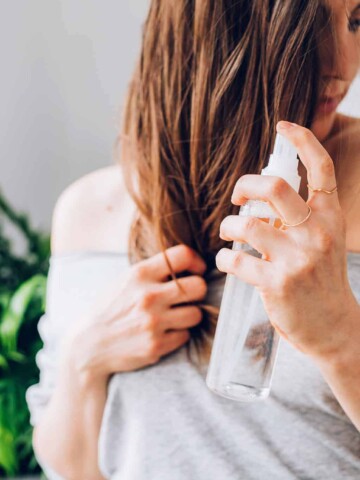Who hasn't had a bad hair day at least once in their life? Personally, I feel like I've been having a bad hair decade. But I've found that nourishing my hair with weekly massages using a customized oil has helped to minimize the fallout (both literally and figuratively) and improved my scalp health.
Homemade scalp oil can be an easy and effective way to moisturize the scalp, promote healthy hair growth, and address pesky hair issues like dandruff or excess oil production. By combining natural oils, essential oils, and other highly-targeted botanical ingredients, you can create a personalized scalp oil blend that suits your hair type and needs.
When combined with a quick massage, scalp oils can even improve blood circulation, reduce inflammation, and enhance the overall health and appearance of your hair.

The Best Oils for Scalp Treatments
Some herbs and essential oils contain compounds that are known to nourish skin and improve hair health, starting at the root. While there are many different botanicals to choose from, here are a few of my favorites for conditioning locks, soothing irritation, boosting moisture (buh-bye flakes), and plumping strands. Go ahead and make your own blends from the ingredients below, or read on for a few recipe ideas you can take for a test drive.
Best Carrier Oils for Scalp
Olive oil
This commonly used cooking oil is chock full of healthy fats and anti-inflammatory compounds. Along with its many health benefits, it has powerful antioxidants, polyphenols, and oleuropein, which help to heal damage and protect cells [source]. When used on the hair, olive oil can moisturize and help to reduce scalp irritation.
Jojoba oil
Because it’s lightweight, odorless, and incredibly soothing, jojoba oil has long been used as a natural hair moisturizer. It has a host of beneficial properties, including everything from fighting bacteria to calming inflammation to its use as a biolubricant [source]. When it comes to hair, jojoba oil’s rich nutrients are said to help penetrate the hair cuticle and nourish the strands from the outside in.
Coconut oil
Coconut oil is a popular choice for hair and scalp care as it contains lauric acid and other fatty acids that can penetrate the hair shaft and moisturize the scalp. This oil can help to reduce dandruff, prevent hair breakage, and promote healthy hair growth. Coconut oil also has antimicrobial properties that can help to fight fungal and bacterial infections on the scalp [source].
Castor oil
Castor oil is a thick and viscous oil that is high in ricinoleic acid [source], a fatty acid known for its anti-inflammatory properties. This oil can soothe an itchy or inflamed scalp and promote healthy hair growth. Castor oil also contains vitamin E, minerals, and proteins that can nourish the scalp and improve the overall health of the hair.
Argan oil
Argan oil is a lightweight and non-greasy oil that is rich in antioxidants and essential fatty acids. This oil can help to moisturize the scalp and prevent dryness and itching.
Argan oil also contains vitamin E [source], a powerful antioxidant that can help to repair damaged hair and protect it from environmental stressors such as sun damage and pollution.
Best Herbs for Scalp
Horsetail extract
Horsetail extract is far and away the star of this hair oil. It is rich in the mineral silica [source], which strengthens bones [source], skin, and hair. And it contains selenium, which is essential for hair growth. A few drops of horsetail extract mixed with essential oils can do wonders for the scalp.
Nettle
Stinging nettles are actually weeds often picked and brewed into a tea to extract the potassium, magnesium, and chlorophyll they contain. They’re also an amazing source of fatty acids, proteins, and vitamins, and they inhibit the growth of bacteria [source]. While you may drink nettle, you can also reap many of the same benefits by applying it directly to the scalp.
Best Essential Oils for Scalp
Lemongrass
A potent antibacterial and antimicrobial, lemongrass essential oil creates an environment conducive to hair growth. In one study using a lemongrass oil tonic on the scalp, it was shown to be effective in reducing dandruff [source].
Rosemary
According to a 2015 study, rosemary oil was shown to be just as effective as minoxidil at treating hair loss and soothing scalp itch and irritation when used for a 6-month period [source].
Clary sage
Clary sage is often used to reduce oil production while also treating scalp ailments such as dandruff and psoriasis. It has antimicrobial properties to help keep those pesky bacteria from causing or contributing to scalp issues [source], and it can also work to calm any inflammation and swelling of the scalp [source].
Tea tree
Tea tree oil is an essential oil known for its antiseptic and antifungal properties [source]. This oil can help to fight dandruff [source], soothe an itchy scalp, and promote healthy hair growth. Tea tree oil also has a refreshing scent and can help unclog hair follicles, which can improve the overall health of the scalp.
Peppermint
Peppermint oil is an essential oil that has a cooling and refreshing sensation when applied to the hair and scalp. This oil can help to stimulate hair growth by increasing blood flow to the hair follicles [source].
Peppermint oil can also help to soothe an itchy scalp, reduce dandruff, and improve the overall health of the hair.
6 DIY Scalp Oil Treatments for Every Hair Type
It's best to tailor your scalp oil blend to meet your hair's particular needs. If you find that any of these ingredients are too expensive or hard to find, feel free to swap them out for things you already have at home or just leave them out entirely. It's all about what works for you!
1. Scalp Oil for Normal Hair
If you've been blessed with normal hair, you really don't need any special oils in your scalp oil blend. Anything will do!
But this blend combines luxurious argan and avocado oils for deep hydration and nourishment, with rosehip oil for its potent antioxidants and ylang-ylang essential oil for its balancing and mood-lifting properties.
—2 tablespoons argan oil
—2 tablespoons avocado oil
—1 tablespoon rosehip oil
—5 drops ylang-ylang essential oil
Instructions
1. Combine the oils in a bowl and warm them up slightly before applying to your scalp.
2. Massage gently for 5–10 minutes, and then leave it on for an additional 30 minutes before rinsing with shampoo and conditioner.
2. Scalp Oil for Hair Growth
Castor oil is rich in ricinoleic acid, which has been shown to promote hair growth. Coconut oil contains lauric acid, which penetrates the hair shaft and moisturizes the scalp. Pair it with essential oils that help improve scalp circulation and promote hair growth.
—2 tablespoons castor oil
—2 tablespoons coconut oil
—1 tablespoon argan oil
—5 drops peppermint essential oil
—5 drops rosemary essential oil
—5 drops lavender essential oil
Instructions
1. Mix all ingredients in a bowl and warm up the blend slightly before applying to your scalp.
2. Massage gently for 5–10 minutes, and leave it on for an additional 30 minutes before rinsing with shampoo and conditioner.
3. Scalp Oil for Thin Hair
You can use this blend as a 15-minute hair treatment before washing, as an overnight mask, or as part of a scalp massage session if you’ve got the time. Personally, I prefer to use it in combination with a scalp massage.
Not only does a massage improve blood flow and really help the oils sink into the skin, but it can also support the hair to grow more quickly and look healthier in general.
—2 tablespoons olive oil
—2 tablespoons jojoba oil
—10 drops horsetail extract
—6 drops lemongrass essential oil
—5 drops clary sage essential oil
Instructions
1. Combine all the ingredients in a 4-ounce glass dropper bottle. Screw the cap on tightly and shake well to blend everything together. Because horsetail extract is water-based, you'll need to shake well before each use.
2. To use, place several drops of oil on your fingertips and rub your hands together to evenly distribute them. Run your fingers through your hair at the scalp, starting at the front hairline and finishing at the base of the neck. Apply more oil as needed.
4. Scalp Oil for Dry Hair
This simple blend contains nourishing jojoba and almond oils to help replenish moisture at the scalp and regulate the scalp's natural oil production and lavender essential oil for added moisture and a calming scent.
—2 tablespoons almond oil
—1 tablespoon jojoba oil
—5 drops lavender essential oil
Instructions
1. Mix all ingredients in a bowl and warm up the blend slightly before applying to your scalp.
2. Massage gently for 5–10 minutes, and leave it on for an additional 30 minutes before rinsing with shampoo and conditioner.
5. Scalp Oil for Oily Hair
This blend uses lightweight grapeseed oil and powerful tea tree oil to help control excess oil production. Plus, it adds lemon and rosemary essential oils to clarify and reinvigorate the scalp without weighing hair down.
—2 tablespoons grapeseed oil
—2 tablespoons tea tree essential oil
—1 tablespoon lemon essential oil
—1 tablespoon rosemary essential oil
Instructions
1. Mix all ingredients in a bowl or glass dropper bottle. To use, warm up the blend slightly before applying a few drops to your scalp.
2. Massage gently for 5–10 minutes, and leave it on for an additional 15 minutes before shampooing and conditioning as usual.
6. Scalp Oil for Dandruff
In this blend, moisturizing olive and castor oils are used to help soothe the scalp. Meanwhile, tea tree and chamomile essential oils are added for their antifungal and soothing effects, while nettle extract inhibits bacterial growth.
—2 tablespoons olive oil
—2 tablespoons castor oil
—10 drops tea tree essential oil
—5 drops chamomile essential oil
—15 drops nettle extract
Instructions
1. Mix all ingredients in a bowl or glass dropper bottle. Place a few drops of the oil mixture directly onto the scalp.
2. Using the pads of your fingers, gently massage it into the scalp for 5–10 minutes, and leave it on for an additional 15–30 minutes before washing with shampoo.
How to Oil the Scalp
Following these steps will help you apply oil to your scalp effectively and leave your hair looking shiny and healthy.
Choose an oil: You can use any oil that suits your hair type, such as coconut, olive, or almond oil. You can also mix different oils to create a custom blend like the ones in this post.
Prepare the oil: Warm the oil slightly by placing it in a microwave-safe container and heating it for 10–15 seconds. Alternatively, you can heat it on the stove in a small pan over low heat until it's warm but not too hot.
Section your hair: Use a comb to section your hair into small parts. This will help you apply the oil more evenly and reach all areas of your scalp.
Apply the oil: Using your fingertips or a small brush, apply the oil to your scalp, starting at the hairline and working your way back. Massage the oil into your scalp with gentle circular motions.
Continue applying the oil: Move on to the next section of your hair, and repeat the process until you have covered your entire scalp.
Distribute the oil through your hair: Once you have applied the oil to your scalp, use a comb or brush to distribute it through the rest of your hair. Be sure to coat the ends of your hair, as they tend to be more dry and prone to damage.
Leave the oil on: Leave the oil on your scalp and hair for at least 30 minutes or overnight if possible. Cover your hair with a shower cap or towel to keep the oil from getting on your pillowcase.
Wash your hair: After the allotted time has passed, wash your hair as usual with a gentle shampoo and conditioner. You may need to shampoo your hair twice to remove all the oil.
How often to oil your scalp
The frequency with which you should oil your scalp depends on your hair type, scalp condition, and personal preference. As a general guideline, once or twice a week is recommended. However, if you have a dry scalp or dry hair, you may benefit from more frequent oiling, up to 3–4 times per week. Conversely, if you have an oily scalp, you may want to limit oiling to once a week or less.
It's important to note that applying too much oil or oiling too frequently can lead to greasy hair, clogged hair follicles, and scalp irritation. It's best to start with a small amount of oil and see how your hair and scalp respond before increasing the frequency or amount of oil used. Ultimately, the best way to determine how often to oil your scalp is to listen to your hair and scalp and adjust your routine accordingly.
Scalp Oil FAQ
What are the benefits of oiling your scalp?
Oiling your scalp can help to moisturize it, nourish the hair follicles, reduce dandruff and itchiness, and promote healthy hair growth.
Can I leave scalp oil on overnight?
Yes, leave scalp oil on overnight for a more intensive treatment. Cover your hair with a shower cap or towel to prevent staining your pillowcase, and rinse thoroughly in the morning.
What are the best oils to use for scalp oiling?
Coconut oil, castor oil, argan oil, and tea tree and peppermint essential oils (diluted) are some of the best oils for scalp oiling, depending on your hair type and scalp condition.
Do I need to shampoo my hair after oiling my scalp?
Yes, it's important to wash your hair after oiling your scalp to remove any excess oil and prevent greasiness.
Can scalp oil help with hair growth?
Yes, some oils in scalp oil blends, such as rosemary essential oil, have been shown to promote hair growth by stimulating hair follicles and improving circulation to the scalp. When combined with a scalp massage, scalp oil can also boost blood flow to the scalp, resulting in healthier hair.
Can scalp oil cause hair loss?
No, scalp oil should not cause hair loss. In fact, nourishing and moisturizing the scalp may help prevent hair loss caused by dryness or inflammation.
References:
1. Gorzynik-Debicka M, et al. Potential health benefits of olive oil and plant polyphenols. Int J Mol Sci. 2018.
2. Al-Obaidi JR, et al. A review on plant importance, biotechnological aspects, and cultivation challenges of jojoba plant. Biol Res. 2017.
3. Lin TK, et al. Anti-inflammatory and skin barrier repair effects of topical application of some plant oils. Int J Mol. Sci. 2017.
4. Patel VR, et al. Castor oil: properties, uses, and optimization of processing parameters in commercial production. Lipid Insights. 2016.
5. Gharby S, et al. Argan oil: chemical composition, extraction process, and quality control. Front Nutr. 2022.
6. Volkov VV, et al. Distributions of silica and biopolymer structural components in the spore elater of Equisetum arvense, an ancient silicifying plant. Front Plant Sci. 2019.
7. Price CT, et al. Silicon: a review of its potential role in the prevention and treatment of postmenopausal osteoporosis. Int J Endocrinol. 2013.
8. Dregiel D, et al. Urtica spp.: ordinary plants with extraordinary properties. Molecules. 2018.
9. Chaisripipat W, et al. Anti-dandruff hair tonic containing lemongrass (Cymbopogon flexuosus) oil. Forsch Komplementmed. 2015.
10. Panahi Y, et al. Rosemary oil vs minoxidil 2% for the treatment of androgenetic alopecia: a randomized comparative trial. Skinmed. 2015.
11. Kuźma Ł, et al. Chemical composition and biological activities of essential oil from Salvia sclarea plants regenerated in vitro. Molecules. 2009.
12. Moretti MD, et al. A study on anti-inflammatory and peripheral analgesic action of Salvia sclarea oil and its main components. J Essent Oil Res. 1997.
13. Carson CF, et al. Melaleuca alternifolia (tea tree) oil: a review of antimicrobial and other medicinal properties. Clin Microbiol Rev. 2006.
14. Satchell AC, et al. Treatment of dandruff with 5% tea tree oil shampoo. J Am Acad Dermatol. 2002.
15. Zhao H, et al. Peppermint essential oil: its phytochemistry, biological activity, pharmacological effect and application. Biomed Pharmacother. 2022.
23








Leave a Comment